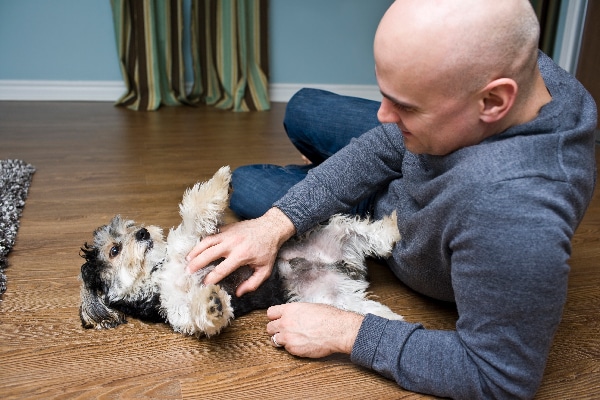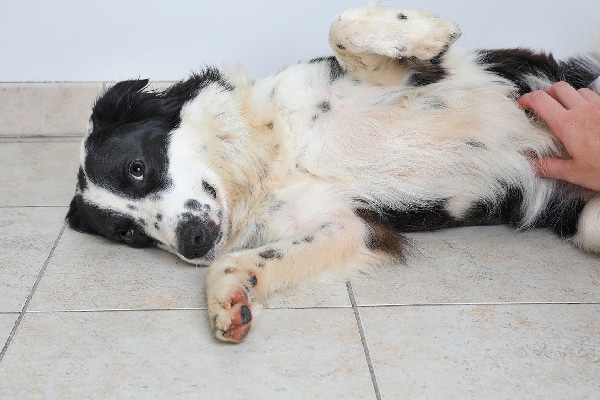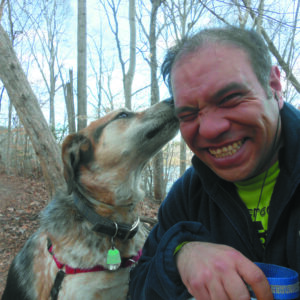Humans, navel-gazing and self-obsessed beings as we are, are nothing if not relentlessly and unapologetically anthropocentric. We tend to assume that our experience of the world is the only one that counts, and that anything that is different from us is either strange, weird or otherwise unaccountable. Hence we ask questions like, “Do dogs have belly buttons?” For all placental mammals, of which humans are only one species, an umbilical cord is a necessary part of typical gestation. In humans, a belly button is a scar, a physical reminder of our nine months as uterine passengers.
Do dogs have belly buttons in the same place as humans?

Dogs are physiologically different from humans in many ways; the difference most relevant to the answer, “Do dogs have belly buttons?” is the positioning of a dog’s nipples and navel. In humans, the nipples are toward the top of the torso and the navel toward the bottom. In both male and female dogs, the navel is flanked on either side by nipples.
One reason we think to ask, “Do dogs have belly buttons?” is that we are accustomed to having generally less body hair than dogs and thus having our navels more readily visible. Following a successful whelping, a mother dog removes the umbilical cords from her puppies. Not only is this scar negligible in size compared to a human navel — and generally flat — but it is also rapidly obscured by fur.
There can be no doubt about whether dogs have umbilical cords. Where you find an umbilical cord, you’ll find a belly button. This means that the answer to another frequently asked question — to wit, “Do cats have belly buttons?” — is likewise a resounding yes. In humans, of course, the scar is far more plainly visible — it either sticks out or appears as a small lint-attracting chasm in our lower abdomen.
How do you find your dog’s belly button?
The next question that comes to mind after, “Do dogs have belly buttons?” is how can you find them? Unlike humans, a dog’s belly button is really only visible and noticeable for a short time after birth. For many short- or medium-haired dogs, the best place to seek evidence of the former connective point of the umbilical cord is right around the little tuft of hair where your dog’s coat meets around the base of the ribs. What we might refer to as a dog’s belly button is usually a small thin scar located just below the end of the ribcage, and just above the start of the abdomen.
As far as belly buttons in the animal kingdom go, humans are outliers to have such apparent navels. We’re certainly the only species of placental mammals to decorate them with tattoos or furnish them with jewelry. Monotremes (egg-laying mammals such as the platypus) and marsupials (pouched mammals like the kangaroo) are really the only mammals out there that have no need of a true umbilical cord, and thus not to have a belly button of any kind. Most other placental mammals are more like dogs and cats, in that they have a navel scar which simply fades with time.
A dog’s herniated belly button
Another question that follows after, “Do dogs have belly buttons?” might be, “What if my dog’s belly button is really apparent?” Indeed, the only time you’d have reason to notice a dog’s belly button is if something goes wrong with a puppy’s development. A hernia is one such unfortunate situation. As you may know, a hernia is basically a condition where something meant to be securely positioned inside the body bulges out. An umbilical hernia in dogs is a medical condition in which the small wound created when the umbilical cord is severed does not close over or heal properly. Normally, a wall of muscle seals itself after birth at the spot where the umbilical cord was connected.
In my youth, I had a dog who had a very small knob-like bump where its flat belly button should have been. I never gave it a second thought, but it was probably an uncomplicated umbilical hernia. An uncomplicated umbilical hernia presents no cause for concern, and will often subside of its own accord.
With a complicated umbilical hernia, in which parts of the internal abdomen, such as a bit of intestine, protrude through the gap in the muscle wall. It’s only when you notice a dog with a pronounced dog belly button at all that you should give a dog’s navel any serious thought. Since this kind of hernia is most common in young puppies, most canine patients can have the problem surgically repaired around the same time that they are spayed or neutered.
Although they can occur in any breed, certain dog breeds are genetically predisposed to develop umbilical hernias, either complicated or uncomplicated. Prospective owners of Airedale Terriers, Basenjis, Beagles, and Pekingese should keep a close watch on newborns and puppies in the first few months of life, just to be safe.
Can you find your dog’s belly button?
Dog belly buttons are inherently fascinating to humans from the moment we notice them as infants or toddlers. While many animals play with or poke around in their ears, we are probably the only ones that bother with the spot where our umbilical cord once provided nutrients and waste disposal during gestation.
Tell us: Have you ever patted or rubbed your dog’s belly, just sort of feeling around to see if you could locate the navel? Has your dog ever dealt with an umbilical hernia? Share your thoughts and experiences in the comments!
Learn more about dogs with Dogster:
- 9 Tips for Keeping Your Dog Cool This Summer
- Let’s Talk: Does Your Dog Love to Roll in Stinky Things?
- Be Polite to Your Dog — It Benefits Both of You
Featured Image Credit: GeorgePeters | iStock / Getty Images Plus.






